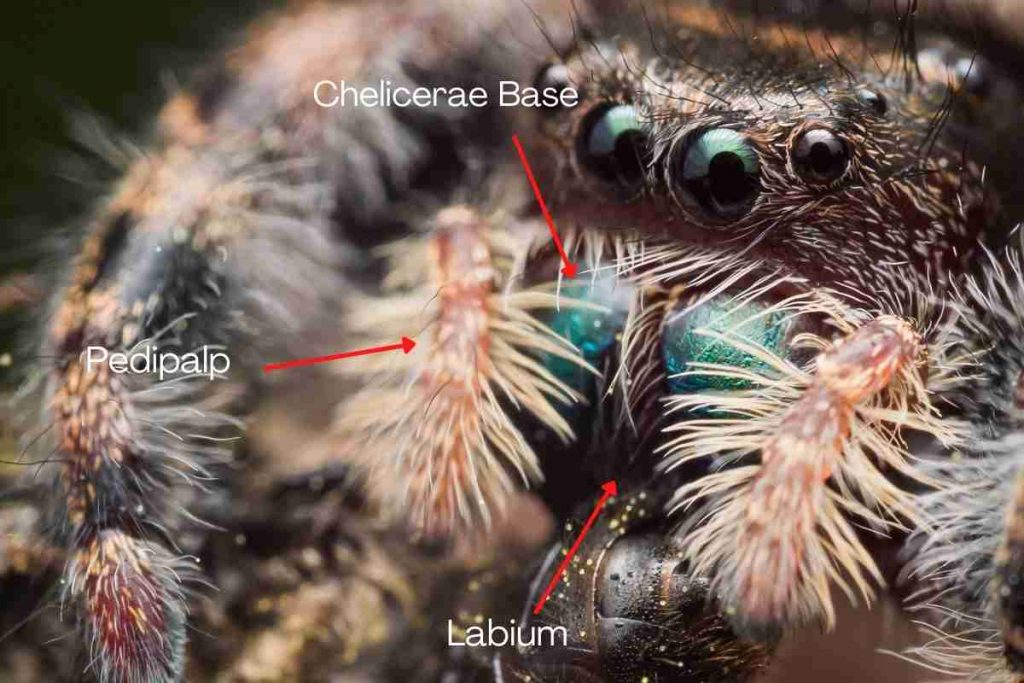Have you ever wondered whether spiders have tongues? Well, In short, spiders don’t have tongues in the traditional sense. However, they do have appendages (pedipalps) that serve a similar function.
But, what are pedipalps you ask? well, to explain this in more detail let’s take a look at the spider’s mouth structure below.
Spider’s Mouth Structure
Spiders are able to capture and consume prey much larger than themselves thanks to their unique mouth structure. The mouthparts of a spider are highly adapted to their hunting and feeding habits and is made up of three parts and each one has its own specific function.
Chelicerae
The chelicerae of a spider are the sharp, fang-like mouthparts that are used to catch and inject venom, immobilizing and killing their prey. They then use their mouth to mash up and suck all the nutrients from whatever they are eating.
The chelicerae are hinged, allowing the spider to open its mouth wide for feeding. When not in use, the chelicerae are held close to the body protecting their mouth.
The structure varies depending on the type of spider. For example, tarantulas have large, powerful Chelicerae that can crush and kill their prey while widow spiders are much longer and thinner.
Pedipalps
Spiders also have what’s called “Pedipalps” which are basically a second pair of appendages located between the first pair of legs on the cephalothorax.
Pedipalps are made up of six segments, each with its own joint and muscle. The first two segments (the coxa and trochanter) are very small and not always visible.
The third segment (the femur) is much longer, and the fourth segment (the patella) is slightly shorter. The fifth and final segments, the tibia and tarsus, make up the spider’s “foot.”
The tibia has a sharp claw at the end, which the spider uses to capture prey.
Spiders use their pedipalps in a variety of ways. Some spiders use them to sense vibrations in their webs, helping them to locate prey.
Other spiders use their pedipalps to spin webs or wrap prey in silk. Some species of male spiders even use their pedipalps to transfer sperm to the female during mating.
In some cases, spiders will also use their pedipalps to clean their eyes or feel around their surroundings.
Labium
When it comes to feeding, spiders have a few different options. For example, some spiders, like the wolf spider, will chase down their prey and kill it before eating it. While others, like web-building spiders, will wait for their prey to come to them.
However, when spiders eat they use what’s called the labium! The labium is basically a small flap of skin that covers the spider’s mouth and helps guide and funnel the food into the spider’s stomach.

How Do Spider’s Taste Receptors Work?
So if a spider has no tongue how do they taste? Learning about how a spider’s taste receptors work can help us to understand why spiders don’t have tongues.
Spiders have taste receptors located on their pedipalps which helps them identify their food. These receptors work by detecting chemicals in the air and on the surface of their prey.
The chemicals are then converted into electrical impulses that are sent to the spider’s brain. These same receptors are also used to determine whether a potential mate is suitable.
How Do They Drink Water?
Spiders generally do not drink water, instead, they get all the moisture they need from the insects they eat. When a spider eats an insect, it first injects it with digestive enzymes that break down the prey’s body tissues.
The liquefied prey is then sucked into the spider’s body, providing not only moisture but also a ready source of nutrients. This efficient method of harvesting water has allowed spiders to thrive in a wide range of habitats.
Conclusion
So there you have it, spiders don’t have tongues in the traditional sense of the word, but they do have appendages (pedipalps) that serve a similar purpose.
While these appendages don’t have taste buds as our tongues do, they do work in the same sort of manner.
Related Article:



